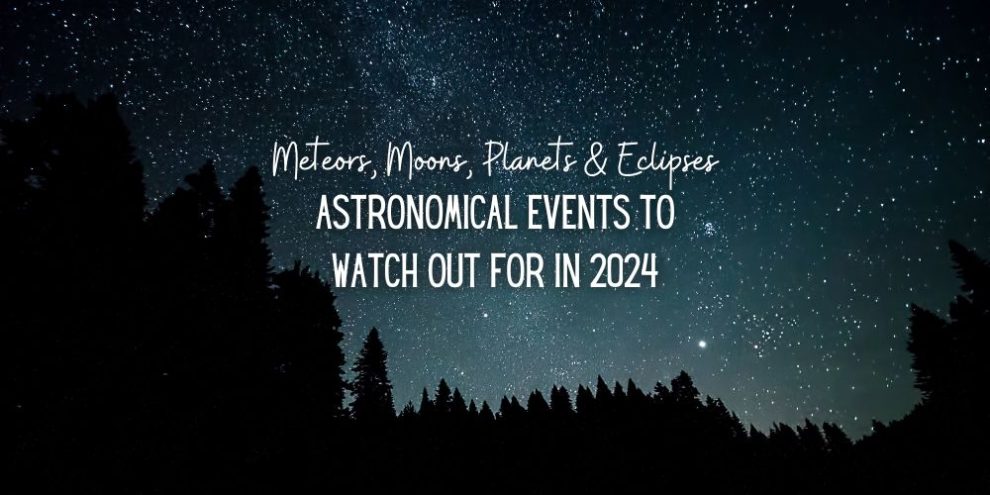
Get ready to mark your calendars because 2024 is bringing us a sky full of incredible astronomical events!
From stunning meteor showers to mesmerizing eclipses (including a total solar eclipse), the universe has quite the show in store for us this year.
It's time to prepare for nights filled with wonder as we witness the dance of planets, the sparkle of shooting stars, and the beauty of glowing moons lighting up our skies.
| January | February | March | April | May | June | July | August | October | November | December |
January
January 3 to 4: Quadrantids Meteor Shower
The Quadrantids is an annual meteor shower that begins in December and peaks in early-January. The meteors originate from an asteroid and appear to come from "Quadrans Muralis,” a defunct constellation located between Bootes and Draco.
Considered one of the best annual meteor showers, there are approximately 120 meteors per hour at the peak of Quantrids.
To view the shooting stars at their best, find somewhere away from lights, point your feet northeast and look up. Within 30 minutes your eyes should adjust and you will be able to see the meteors.
The show will last until dawn.
January 12: Mercury Before Sunrise
Just before sunrise on January 12, Mercury will be at the highest point in the sky as it reaches its farthest distance from the sun. This will provide for excellent views of the planet in the Eastern sky.
January 25: Wolf Moon
The first full moon of the year is the Wolf Moon. The name is believed to have originated from the increased activity of wolves during this time of year and their howls as they search for scarce amounts of food in the midwinter.
Other names include Bear Hunting Moon, Goose Moon, Cold Moon, and more.
In North America, the best views will be seen January 25 just after sunset.
February
February 24: Snow Moon
The second full moon of the year is the Snow Moon. As you may have guessed, the name comes from the deep snow that covers the ground in Northern locales.
Because the moon is at one of its farthest points from earth, the moon will be a micromoon.
To see the snow moon at its best, look to the sky just before sunrise on Saturday morning.
March
March 19: Spring Equinox
In 2024, spring will begin on March 19.
March 25: Worm Moon And Lunar Eclipse
The March full moon is called the Worm Moon. Its name is said to refer to the emergence of earthworms as winter turns to spring. While it will peak at 3 AM, you will be able to see it in its glory as it rises in the early evening.
Set to pass through earth’s shadow, we will also experience a penumbral lunar eclipse on March 25.
The moon will appear dimmer, during the eclipse. To appreciate the subtle shift in luminescence, you will want a pair of binoculars or a telescope.
April
April 8: Total Solar Eclipse (Sort Of)
On Monday April 8, 2024, the moon will completely block out the sun in large parts of North America. It will begin in Mexico and Exit in Canada.
While Simcoe County won’t technically experience a total eclipse, it will be close with almost 98% obscuration (i.e. concealment). Toronto will see 99.92% obscuration, while 100% will be witnessed in Bellville, Brantford and other areas in those regions.
Remember, never look directly at the sun during a solar eclipse unless you have specialized eye protection.
April 21 to 22: Lyrid Meteor Shower
The Lyrid Meteor Shower is another annual occurrence that appears to come from Constellation Lyra. The meteors are the result of space debris from Comet Thatcher, which was discovered in 1861.
At peak activity, there will be around 18 meteors per hour. Look towards the east for the best view.
These particular shooting stars burn fast and bright. As a result they rarely have glowing dust trails, though they can produce bright flashes called a fireball.
This year’s show will be affected by the brightness of the waxing gibbous moon, making it difficult to spot the meteors in the night sky.
April 23: Pink Moon
The second full moon of the Spring is called the Pink Moon. The name is not associated with the colour of the moon itself. Instead, April’s moon gets its name from early springtime blooms, specifically creeping phlox.
Like other moons, the Pink Moon is known by many other names such as the Sucker Moon, Frog Moon, Breaking Ice Moon and more.
May
May 5 to 6: Eta Aquarid Meteor Shower
Eta Aquarids will be at its peak during the night between May 5 and 6. While they are viewable in both hemispheres, they are not as spectacular in the north. In our neck of the woods, they are referred to as Earthgazers, which are long meteors that appear to skim across the surface of the planet near the horizon line.
The meteors originate from Halley’s Comet and appear to come from Aquarius. There are approximately 60 meteors per hour at its peak.
Because the moon’s interference will be limited, viewing should be better in 2024 than in other years.
May 23: Flower Moon
As the month comes to a close, flowers will be growing in abundance, giving to the name of May’s full moon.
In North America, the best viewing will be on the night of May 22 and May 23, as peak illumination will be at 9:53 AM on May 23.
June
June 20: Summer Solstice
Summer officially begins at 4:51 PM on June 20. At this moment, the north pole is at its greatest tilt toward the sun resulting in the longest day of the year.
June 21: Strawberry Moon
The strawberry moon will be at its peak at 9:07 PM on June 21, so the best viewing will happen just after the sun has set.
The reason behind the moon’s name is that June is the peak strawberry season. This makes it one of two moon’s whose names are rooted in agriculture.
July
July 15: Plant Conjunction
On July 15, Mercury, Mars and Uranus will all be visible in the night sky. While they will be visible anytime after sunset, they will be most clear right before sunrise.
While Mars and Uranus will appear to be close they will actually be billions of miles from one another.
July 21: Buck Moon
Bucks begin to grow their antlers in late spring. Come July, the antlers are large and easier to spot. This is what some say led to the name of July’s Buck Moon. Other names include Thunder Moon or Hay Moon.
Peak illumination is at 6:17 AM which means the best viewing will be overnight on July 20 or 21.
This moon will be the last regular full moon for a few months.
August
August 11 to 12: Perseid Meteor Shower
Originating from Comet Swift-Tuttle, Perseids is expected to be one of the best meteor showers of the year. The shower appears to come from Perseus and produces up to 100 meteors an hour at its peak. These meteors are particularly spectacular as they leave long streams of light and colour behind them as they move through the atmosphere. Fireballs are also common during this shower.
In Canada, you can start to spot the meteors as early as 10 PM on August 11 and all the way into the morning of August 12. For the best viewing, head outside during pre-dawn hours.
August 19: Sturgeon Moon
August’s moon is the Sturgeon moon. This year it’s peak brightness will be at 2:25 PM, so you will have to wait until the night of August 19 for the best viewing.
One of four supermoons, this moon will appear brighter and larger than usual. It will also be a seasonal blue moon, though, like Pink Moon, the title does not refer to the colour of the moon itself.
You see, most seasons only have 3 months but due to the Moon’s cycle of 29.5 days, usually a season will only see 3 full moons. When there are four full moons in a season, the 3rd moon, in this case August’s moon, is a seasonal blue moon.
Blue moon’s are not uncommon though the phrase “once in a blue moon” may make it seem otherwise.
September
September 8: Saturn Cozies Up To Earth
Saturn will be at its closest approach to Earth on September 8th. The planet will be easily seen with the naked eye, though a telescope will be needed to see its rings.
If you have a telescope, you may also be able to see some of the planets' many moons.
September 17: Harvest Moon
Unlike other moon’s, the Harvest Moon isn’t exclusive to a single month. Instead, it is the name for the full moon that’s closest to the autumn equinox. As a result, the Harvest Moon is sometimes in October.
It’s said that this moon was especially important as its light would allow farmers to work late into the evenings during their annual fall harvest.
September’s Harvest Moon will be the second supermoon of the year. It will also produce a partial lunar eclipse in the Northern Hemisphere though the concealment will be so minor it may be missed.
September 20: Neptune Cozies Up To Earth
Neptue will make its closest approach to Earth on September 20. Unlike saturn, Neptune is hard to spot, which is why you’ll want a telescope to see this one.
September 22: Fall Equinox
The fall equinox is the exact moment that the sun appears directly over the equator and marks the beginning of Fall. The time and date of equinoxes varies from one year to the next. This year, the fall equinox is at 8:43 AM on September 22.
October
October 2: Annular Solar Eclipse
An annular solar eclipse is when the moon covers the sun in such a way that the outer edges of the sun are visible. This create a ring of fire, also known as an annulus, around the moon.
Unfortunately, this eclipse will only be visible in large parts of the Pacific Ocean. Hawaii is the only state that will see it.
October 8: Draconid Meteor Shower
From October 6 to 10, the Draconid Meteor Shower will be visible. Unlike other meteor showers, Draconids only produce a handful of meteors per hour.
Peak viewing in Barrie will be from October 7 to 8.
October 13: Flyby Comet
Comet Tsuchinshan–ATLAS, discovered in 2023, will be visible to the naked eye as it passes by earth.
The comet is not a threat and sightings should last approximately a week.
October 17: Hunter’s Moon
October’s full moon will be at peak illumination at 7:26 am on the 17. For the best view, you can take a look on the night of the 16th or 17th.
Another supermoon, this moon marks the time of year when people would start stocking up on food to get through the winter.
October 20 to 21: Orionid Meteor Shower
Appearing to come from the Constellation Orion, the Orionid meteor shower will be at its peak on October 20 and 21.
Unfortunately, its closeness to the full moon will make the meteors appear dimmer and harder to see.
November
November 15: Beaver Moon
November’s Beaver Moon will be the last supermoon of the year. It will peak at noon, which means its best view in our area will be on the night of the 15.
Some believe the name of November’s Moon comes from beaver’s building dams in November before the water freezes while others think it has to do with when traps are put out.
November 18: Leonid Meteor Shower
Comet Tempel-Tuttle will produce the Leonids Meteor Shower in November. The meteors will appear to come from Constellation Leo and are some of the fastest meteors, travelling at 71 km per second.
Generally, you will see about 15 meteors per hour, though every 33 years or so, there can be hundreds or thousands per year. The last show like this was in 2002.
This year, it will be hard to see the meteors due to the showers closeness to the full Beaver Moon.
December
December 6: Jupiter Cozies Up To Earth
Jupiter will be visible for the entire night and will be as bright as many of the stars we see in the sky.
If you have access to a telescope, you should be able to spot some of the planet's 95 moons.
Throughout the night, you should be able to spot Venus, Mars and Neptune at different times.
December 14: Geminid Meteor Shower
The Geminid Shower happens when Earth passes through pieces of the Phaethon Asteroid.
Normally this is one of the better meteor showers of the year, however, in 2024, the peak of the shower is so close to the full moon that visibility will be limited.
December 15: Cold Moon
The year will end with the full Cold Moon on December 15 at 4:02 AM.
The name comes from the cold weather that December brings as fall turns into winter.
December 21: Winter Solstice
The first day of winter will be on December 21 at 4:19 AM. This day is the shortest day of the year. Moving forward from this date, every day will have a bit more sunlight than the last.
December 21 to 22: Ursid Meteor Shower
Named after Ursa Minor, where the meteors seemingly come from, the Ursid Shower produces up to 10 shooting stars per hour.
Visibility will be hindered due to the brightness of the moon, which will be full at the same time.
Don’t Miss Out On These Stunning Astronomical Events
What a year it's going to be for skywatchers!
From the promise of meteor showers lighting up our skies to the anticipation of witnessing planets aligning in their cosmic dance, the upcoming year holds a treasure trove of astronomical marvels. Get ready to embark on a journey of discovery, exploring the mysteries and beauty that the universe has in store for us.
Here's to the thrilling adventures awaiting us in the night sky!











